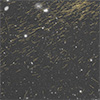| Oct 13, 2023 |
|
|
|
(Nanowerk News) Showers in bathrooms bring us comfort; showers from space bring astrophysicists joy. Osaka Metropolitan University scientists have observed, with their novel method, cosmic-ray extensive air showers with unprecedented precision, opening the door to new insights into the Universe’s most energetic particles.
|
|
When a high energy cosmic ray collides with the Earth’s atmosphere, it generates an enormous number of particles known as an extensive air shower. A research team led by Associate Professor Toshihiro Fujii from the Graduate School of Science and Nambu Yoichiro Institute of Theoretical and Experimental Physics at Osaka Metropolitan University, along with graduate student Fraser Bradfield, has discovered that the prime-focus wide field camera mounted on the Subaru Telescope, situated atop the Mauna Kea volcano in Hawaii, can capture these extensive air showers with extremely high resolution.
|
|
The findings have been published in Scientific Reports (“Observing cosmic-ray extensive air showers with a silicon imaging detector”).
|
 |
| An example of a cosmic-ray extensive air shower recorded by the Subaru Telescope. The highlighted tracks, which are mostly aligned in similar directions, show the shower particles induced from a high-energy cosmic ray. (Image: National Astronomical Observatory of Japan, Hyper Suprime-Cam (HSC) Collaboration)
|
|
The Subaru Telescope was designed for observational astronomy. Cosmic rays, appearing as “tracks” on the observed images and obscuring the targeted stars or galaxies, are dismissed as noise by usual astronomical data processing. However, this team’s research focuses on that very “noise.” Analyzing approximately 17,000 images captured between 2014 and 2020, the research team pinpointed 13 images that contained extensive air showers. These images displayed a far larger number of particle tracks than usual.
|
|
“With conventional observation methods, it is challenging to distinguish between the types of particles that constitute extensive air showers,” explained Professor Fujii. “Our method, on the other hand, has the potential to determine the nature of individual particles.”
|
|
Professor Fujii added, “Furthermore, by integrating our method with conventional approaches, we hope to advance our understanding of extensive air showers. This technique may allow us to search for dark matter or other exotic particles, offering additional insights into the transition of the Universe into a matter-dominated era.”
|


